The Toshiba OCZ RD400 (256GB, 512GB, 1TB) M.2 PCIe SSD Review
by Billy Tallis on May 25, 2016 8:02 AM ESTRandom Read Performance
The random read test requests 4kB blocks and tests queue depths ranging from 1 to 32. The queue depth is doubled every three minutes, for a total test duration of 18 minutes. The test spans the entire drive, which is filled before the test starts. The primary score we report is an average of performances at queue depths 1, 2 and 4, as client usage typically consists mostly of low queue depth operations.
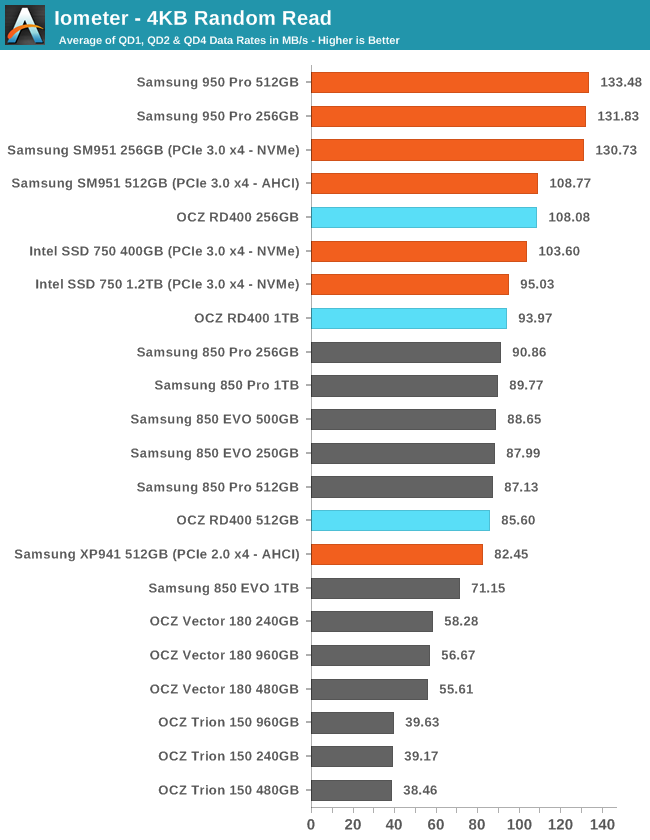
There's not a significant random read speed gap between PCIe drives and SATA drives as the unavoidable NAND latency and controller/firmware design matter more than the speed of the host interface. The RD400 performance is a bit odd, with the 512GB RD400 falling behind several SATA drives while the 256GB RD400 is clearly the fastest capacity.
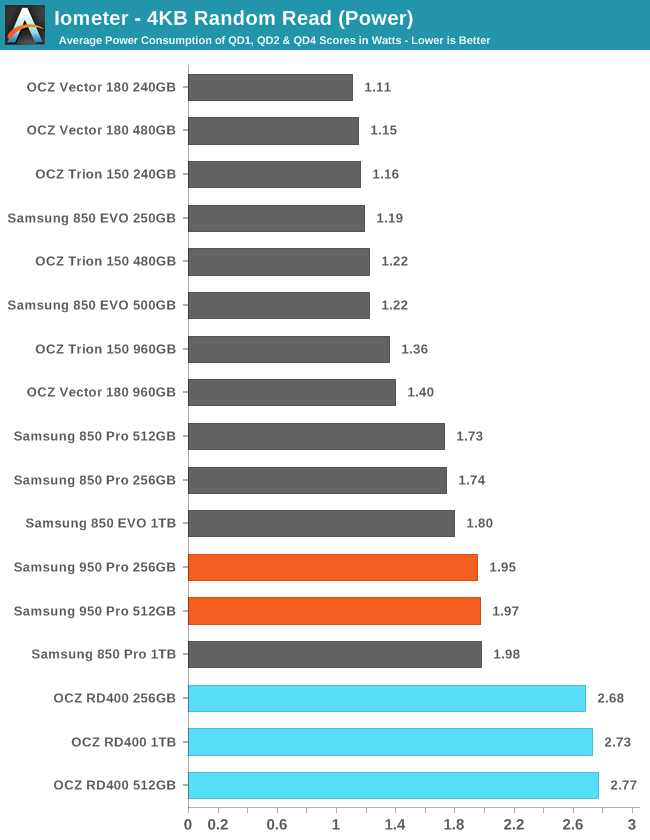
The RD400 again draws significantly more power than the other drives we've measured while the Samsung 950 Pro is a similar load to high-end SATA drives.
 |
|||||||||
The RD400's random read speed scales smoothly with queue depth and unlike the Samsung drives it shows no signs of performance reaching a plateau near the end of the test.
Random Write Performance
The random write test writes 4kB blocks and tests queue depths ranging from 1 to 32. The queue depth is doubled every three minutes, for a total test duration of 18 minutes. The test is limited to a 16GB portion of the drive, and the drive is empty save for the 16GB test file. The primary score we report is an average of performances at queue depths 1, 2 and 4, as client usage typically consists mostly of low queue depth operations.
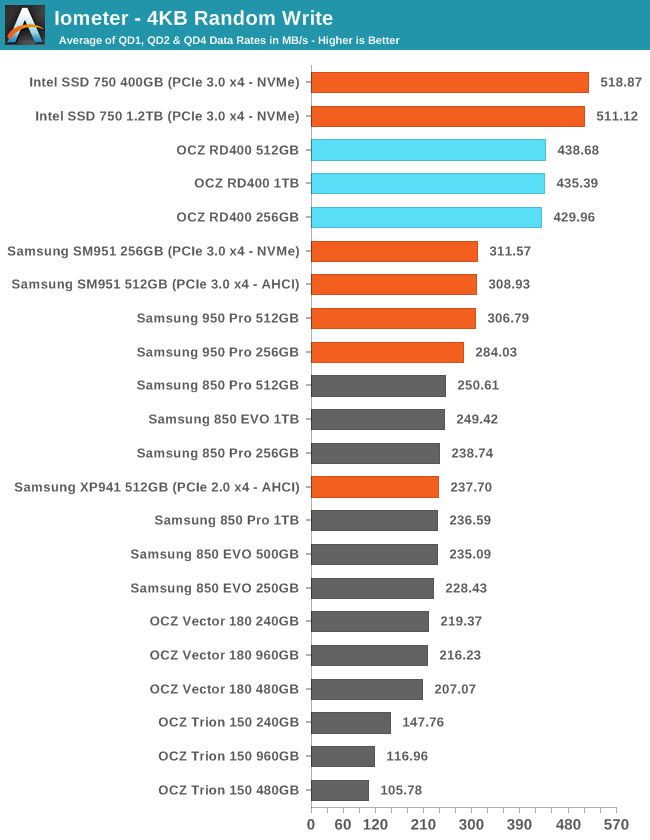
The Intel 750's enterprise roots show through quite clearly as it delivers the fastest random write speeds, but the RD400 is a strong second place. Samsung's PCIe 3 drives provide only moderate improvement over SATA. This stratification illustrates just how much NVMe drivers, controllers and firmware can differ even when the underlying PCIe link is not clost to full utilization.
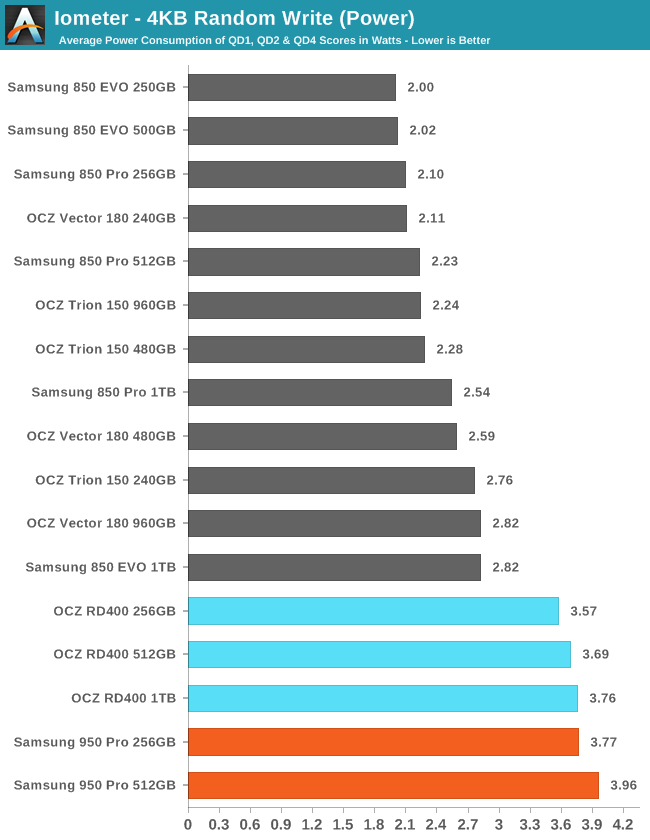
In addition to providing better random write speeds than the 950 Pro, the RD400 manages to use a bit less power, giving it a clear efficiency win.
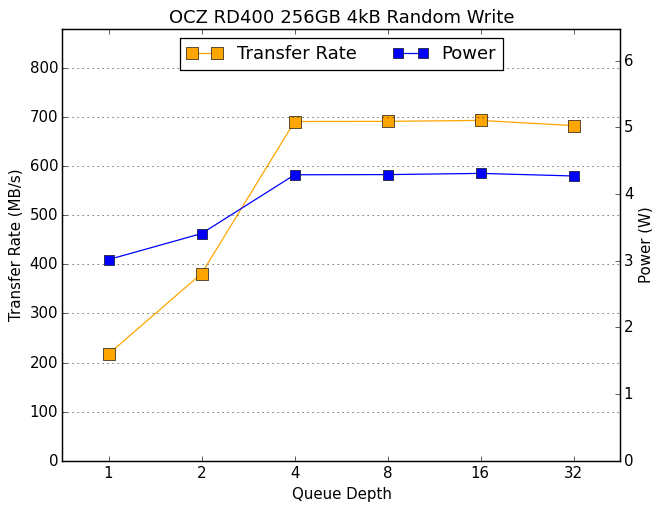 |
|||||||||
The RD400 reaches full speed by QD4 and maintains it for the rest of the test save for a bit of a drop on the 1TB RD400 near the end as the drive begins to run out of spare area and potentially triggers some thermal throttling.










40 Comments
View All Comments
AnnonymousCoward - Wednesday, May 25, 2016 - link
What about boot time. Is it slow like the Intel card?mervincm - Wednesday, May 25, 2016 - link
Intel 750 SSD isn't slow at boot anymore. Later SSD firmware and NVME drivers have really helped my boot performance.Yregister - Thursday, November 3, 2016 - link
But that's on Windows, correct? I read that the 750 doesn't work on a Mac, not bootable...moheban79 - Saturday, November 12, 2016 - link
Thats not true. I got my Intel 750 booting up my hackintosh. Should be doable.adamto - Wednesday, May 25, 2016 - link
Why there is no 2T or even 4T M.2 SSD?Silma - Wednesday, May 25, 2016 - link
Because there isn't enough place on the stick. One would need to develop much denser NAND.Billy Tallis - Wednesday, May 25, 2016 - link
A double-sided M.2 2280 can usually fit four packages of flash, each containing a stack of up to 16 dies that are typically 128Gb (16GB). That multiplies out to a practical limit of 1024GB for now. Newer 3D NAND such as Micron's will be available in 256Gb MLC dies, enabling 2TB M.2 2280 drives (or 3TB with TLC).Dr.Neale - Wednesday, May 25, 2016 - link
Don't you mean 4 TB with TLC?Billy Tallis - Wednesday, May 25, 2016 - link
We're not quite there yet. Micron's 3D TLC is 384Gb and everybody else seems to be going for a 256Gb TLC that will be a smaller die than their 256Gb MLC. A 4TB M.2 would require either a 512Gb die or denser packaging.Chaser - Wednesday, May 25, 2016 - link
"Upgrading from a mechanical hard drive to a SSD alleviates a major performance bottleneck but the experience of moving from SATA SSDs to PCIe SSDs is not as revolutionary. I suspect most consumers would be better served with a larger SSD of moderate performance than a cramped but blazing fast PCIe drive," Thank you!